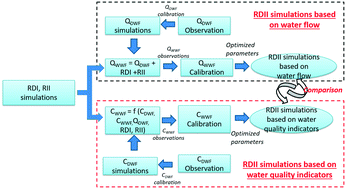当前位置:
X-MOL 学术
›
Environ. Sci.: Water Res. Technol.
›
论文详情
Our official English website, www.x-mol.net, welcomes your feedback! (Note: you will need to create a separate account there.)
Estimating rainfall-induced inflow and infiltration in a sanitary sewer system based on water quality modelling: which parameter to use?†
Environmental Science: Water Research & Technology ( IF 5 ) Pub Date : 2017-12-12 00:00:00 , DOI: 10.1039/c7ew00371d Mingkai Zhang 1, 2, 3, 4, 5 , Yanchen Liu 1, 2, 3, 4, 5 , Qian Dong 1, 2, 3, 4, 5 , Yi Hong 1, 2, 3, 4, 5 , Xia Huang 1, 2, 3, 4, 5 , Hanchang Shi 1, 2, 3, 4, 5 , Zhiguo Yuan 1, 2, 3, 4, 5
Environmental Science: Water Research & Technology ( IF 5 ) Pub Date : 2017-12-12 00:00:00 , DOI: 10.1039/c7ew00371d Mingkai Zhang 1, 2, 3, 4, 5 , Yanchen Liu 1, 2, 3, 4, 5 , Qian Dong 1, 2, 3, 4, 5 , Yi Hong 1, 2, 3, 4, 5 , Xia Huang 1, 2, 3, 4, 5 , Hanchang Shi 1, 2, 3, 4, 5 , Zhiguo Yuan 1, 2, 3, 4, 5
Affiliation

|
Rainfall-derived inflow and infiltration (RDII) of urban sanitary sewer systems poses serious challenges for public health and management issues. Correct estimation of RDII is required for the maintenance of sewer infrastructure, such as sewer rehabilitation and replacement. This study aims to propose a suitable parameter for simulating RDII dynamics based on the variation patterns of wastewater quality indicators. Ten monitoring sewer sites ranging from residential areas to a wastewater treatment plant (WWTP) were equipped for continuous measurements of water flow and four wastewater indicators, including ammonia (NH4+-N), phosphate (PO43−-P), chemical oxygen demand (COD) and conductivity. In order to identify the most representative indicator for modelling the RDII dynamics, simulations based on different wastewater indicators were compared. Sensitivities of different wastewater indicators to RDII estimations were evaluated using the Kolmogorov–Smirnov test (KS test). The results revealed that conductivity was the most sensitive indicator for RDII simulations. Moreover, simulations of RDII based on conductivity have similar dynamics compared with that based on water flow, implying that conductivity could be considered as a suitable indicator for analyzing the RDII. Using the non-linear regression method for parameter optimization, RDII simulations based on conductivity gave promising results at all regional scales.
中文翻译:

基于水质模型估算下水道系统中降雨引起的流入和入渗:使用哪个参数?†
城市卫生污水系统的降雨引起的流入和渗透(RDII)对公共卫生和管理问题提出了严峻的挑战。需要对下水道基础设施进行正确的RDII估算,以维护下水道基础设施,例如下水道的修复和更换。这项研究的目的是根据废水质量指标的变化模式,提出一个合适的参数来模拟RDII动力学。从居民区到废水处理厂(WWTP)的十个监测下水道站点均配备了连续测量水流量和四个废水指标的设备,包括氨(NH 4 + -N),磷酸盐(PO 4 3--P),化学需氧量(COD)和电导率。为了确定最有代表性的RDII动力学建模指标,比较了基于不同废水指标的模拟。使用Kolmogorov–Smirnov试验(KS试验)评估了不同废水指标对RDII估算的敏感性。结果表明,电导率是RDII模拟中最敏感的指标。此外,与基于水流的模拟相比,基于电导率的RDII模拟具有相似的动力学特性,这表明电导率可以被视为分析RDII的合适指标。使用非线性回归方法进行参数优化时,基于电导率的RDII模拟在所有区域尺度上均给出了可喜的结果。
更新日期:2017-12-12
中文翻译:

基于水质模型估算下水道系统中降雨引起的流入和入渗:使用哪个参数?†
城市卫生污水系统的降雨引起的流入和渗透(RDII)对公共卫生和管理问题提出了严峻的挑战。需要对下水道基础设施进行正确的RDII估算,以维护下水道基础设施,例如下水道的修复和更换。这项研究的目的是根据废水质量指标的变化模式,提出一个合适的参数来模拟RDII动力学。从居民区到废水处理厂(WWTP)的十个监测下水道站点均配备了连续测量水流量和四个废水指标的设备,包括氨(NH 4 + -N),磷酸盐(PO 4 3--P),化学需氧量(COD)和电导率。为了确定最有代表性的RDII动力学建模指标,比较了基于不同废水指标的模拟。使用Kolmogorov–Smirnov试验(KS试验)评估了不同废水指标对RDII估算的敏感性。结果表明,电导率是RDII模拟中最敏感的指标。此外,与基于水流的模拟相比,基于电导率的RDII模拟具有相似的动力学特性,这表明电导率可以被视为分析RDII的合适指标。使用非线性回归方法进行参数优化时,基于电导率的RDII模拟在所有区域尺度上均给出了可喜的结果。



























 京公网安备 11010802027423号
京公网安备 11010802027423号